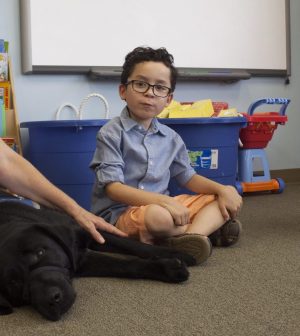- Navigating Your Midlife Crisis: Embracing New Possibilities
- City Raccoons Showing Signs of Domestication
- Mapping the Exposome: Science Broadens Focus to Environmental Disease Triggers
- One Week Less on Social Media Linked to Better Mental Health
- Your Brain Changes in Stages as You Age, Study Finds
- Some Suicide Victims Show No Typical Warning Signs, Study Finds
- ByHeart Formula Faces Lawsuits After Babies Sickened With Botulism
- Switch to Vegan Diet Could Cut Your Greenhouse Gas Emissions in Half
- Regular Bedtime Does Wonders for Blood Pressure
- Dining Alone Could Mean Worse Nutrition for Seniors
Not All Kids With Autism Will Benefit From Therapy Dogs

For many kids with autism, Rhett, a black Labrador retriever, has been a calming and comforting influence in his seven years as a therapy dog.
But parents shouldn’t assume that a service pooch is the solution for every child on the autism spectrum, a new study finds. Not all kids with autism enjoy interacting with Rhett, a resident therapy dog at the University of Missouri’s Thompson Center for Autism and Neurodevelopmental Disorders.
This is the main message from a recent small study that sought to find if and when kids with autism respond to therapy dogs as a motivator to complete tasks and learn new skills.
“The key is to find out what motivates a child with autism, whether it’s playing with a therapy dog or a favorite toy,” said study author Emma Keicher. She is an applied behavior analyst at the center.
Clinics may have therapy dogs on staff to work with kids, and some families may look to adopt a service dog as a companion animal for a child with autism.
There are often long wait lists at organizations that train and place service dogs in homes of kids who have autism. “Before you bring a dog home, make sure your child enjoys playing with dogs,” Keicher said.
There can be many potential benefits of a therapy dog for some kids with autism, she said. “Therapy dogs can be trained to serve as anchors for kids who run away,” she said. In these scenarios, the dog sits down when the child tries to run off. “The dog may serve as a comfort source in difficult social settings,” Keicher added.
But these benefits are only realized if the child responds to and connects with the dog.
”Some kids may hit or kick the dog or don’t have a connection to the dog, and it can become too overwhelming for a family to care for the dog, and they may have to rehome it,” Keicher said.
Autism is a developmental disorder characterized by problems with social interaction, and restricted behaviors or interests. People on the autism spectrum may also have learning differences, movement problems and attention difficulties.
For the study, six boys with autism, aged 4 to 9, were told if they completed certain tasks their reward would be playtime with Rhett or some other form of entertainment, such as playing with toys.
Two boys enjoyed playing with Rhett far more than the toys, two were indifferent and mainly played with the toys, and two didn’t want to play with Rhett at all, the study findings showed.
The report was published online recently in Behavior Analysis in Practice.
There is a lot for a family of a child with autism to consider before working with or adopting a therapy dog, agreed Jack Scott, executive director of the Florida Atlantic University Center for Autism and Related Disabilities, in Boca Raton.
Therapy dogs can be potentially life-saving for some kids with autism, said Scott, who was not involved in the new study.
Seizures are relatively common among people with autism.
“Children with very severe seizures are at risk for falling hard and dangerously, and there are dogs that are trained to recognize the early warning signs of seizures and alert someone to the likely onset of a seizure,” Scott said. Some therapy dogs can save kids with autism from drowning.
Dogs may also help kids with autism make friends on the playground, he added.
Scott’s advice? “Visit friends and families with animals to see how your child responds before investing time and resources in a therapy animal,” he said.
“If you say don’t poke the dog and they don’t get that message, the level of supervision will have to be very close,” Scott explained.
Positive reinforcement — a recommended strategy for parenting a child with autism — is anything that encourages appropriate and desired behavior. Playing with dogs is just one potential form. Other types of positive reinforcement include smiles, tickles, high fives, praise or access to fun activities, Scott said. “Find what works best for your child.”
More information
Autism Speaks has a list of organizations that train and place service dogs for people with autism.
SOURCES: Emma Keicher, applied behavior analyst, Thompson Center for Autism and Neurodevelopmental Disorders, University of Missouri, Columbia; Jack Scott, PhD, executive director, Center for Autism and Related Disabilities, and associate professor, department of special education, Florida Atlantic University, Boca Raton; Behavior Analysis in Practice, April 2022, online
Source: HealthDay
Copyright © 2025 HealthDay. All rights reserved.










